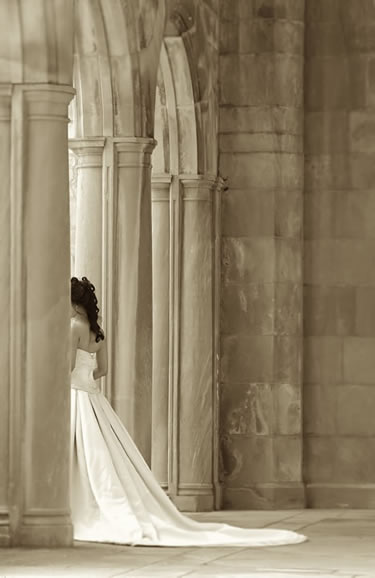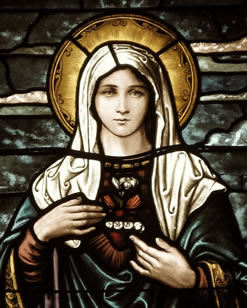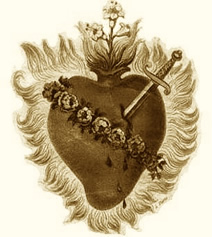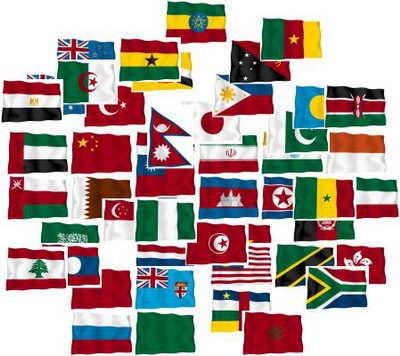
I WANT to give a message of hope—tremendous hope. I continue to receive letters in which readers are despairing as they watch the continual decline and exponential decay of society around them. We hurt because the world is in a downward spiral into a darkness unparalleled in history. We feel pangs because it reminds us that this is not our home, but Heaven is. So listen again to Jesus:
Blessed are they who hunger and thirst for righteousness, for they will be satisfied. (Matthew 5:6)
It is time to shift our eyes from the sorrowful plane of this world and fix them on Jesus because He has a plan, a wonderful plan that will see the triumph of good over evil that will end the chaos and death of this generation and grant—for a period—a time of peace, justice, and unity in order to fulfill the Scriptures in the “fullness of time.”
[John Paul II] does indeed cherish a great expectation that the millennium of divisions will be followed by a millennium of unifications… that all the catastrophes of our century, all its tears, as the Pope says, will be caught up at the end and turned into a new beginning. —Cardinal Joseph Ratzinger (POPE BENEDICT XVI), Salt of the Earth, An Interview With Peter Seewald, p. 237
It will at length be possible that our many wounds be healed and all justice spring forth again with the hope of restored authority; that the splendors of peace be renewed, and the swords and arms drop from the hand and when all men shall acknowledge the empire of Christ and willingly obey His word, and every tongue shall confess that the Lord Jesus is in the Glory of the Father. —POPE LEO XIII, Consecration to the Sacred Heart, May 1899
WHEN ALL SEEMS LOST…
When all has seemed hopeless and utterly lost… that’s when God has  triumphed most powerfully in salvation history. When Joseph was sold into slavery, God delivered him. When the Israelites were bound by Pharoah, the Lord’s wonders released them. When they were dying of hunger and thirst, He opened the rock and rained down manna. When they were trapped against the Red Sea, He parted the waters… and when Jesus appeared to be utterly defeated and destroyed, He rose from the dead…
triumphed most powerfully in salvation history. When Joseph was sold into slavery, God delivered him. When the Israelites were bound by Pharoah, the Lord’s wonders released them. When they were dying of hunger and thirst, He opened the rock and rained down manna. When they were trapped against the Red Sea, He parted the waters… and when Jesus appeared to be utterly defeated and destroyed, He rose from the dead…
…despoiling the principalities and the powers, he made a public spectacle of them, leading them away in triumph by it. (Col 2:15)
So too, brothers and sisters, the painful trial the Church must pass through will make it appear as though everything is utterly lost. The grain of wheat must fall into the ground and die… but then comes resurrection—the Triumph.
The Church will enter the glory of the kingdom only through this final Passover, when she will follow her Lord in his death and Resurrection. —Catechism of the Catholic Church 675, 677
This Triumph is the interior sanctification of the Church, which one could say is the rays of the “brightness” of Christ’s coming [1]2 Thess 2:8; rendered “the brightness of his coming” in the Douay-Rheims, which is the English translation from the Latin before we see Him returning on the clouds in power and glory at the end of time. His “glory” will manifest first in His mystical body before it manifests in His physical body at the end of the world. For Our Lord not only said that He was the light of the world, but “you are the light of the world.” [2]Matt 5:14 That light and glory for the Church is holiness.
I will make you a light to the nations, that my salvation may reach to the ends of the earth… A bright light will shine to all parts of the earth; many nations shall come to you from afar, and the inhabitants of all the limits of the earth, drawn to you by the name of the Lord God… (Isaiah 49:6; Tobit 13:11)
Holiness, a message that convinces without the need for words, is the living reflection of the face of Christ. —POPE JOHN PAUL II, Novo Millennio Ineunte, Apostolic Letter, n. 7; www.vatican.va
Thus, while Satan is forming his “mystical body” through disobedience, Christ is forming His Mystical Body through  obedience. While Satan uses the lustful image of a woman’s body to pollute and deform the purity of souls, Jesus employs the image and model of His Immaculate Mother to purify and form souls. While Satan tramples upon and destroys the sanctity of marriage, Jesus is preparing for Himself a Bride for the Wedding Feast of the Lamb. Indeed, to prepare for the new millennium, John Paul II stated that all “pastoral initiatives must be set in relation to holiness.” [3]POPE JOHN PAUL II, Novo Millennio Ineunte, Apostolic Letter, n. 7; www.vatican.va “Holiness” is the program.
obedience. While Satan uses the lustful image of a woman’s body to pollute and deform the purity of souls, Jesus employs the image and model of His Immaculate Mother to purify and form souls. While Satan tramples upon and destroys the sanctity of marriage, Jesus is preparing for Himself a Bride for the Wedding Feast of the Lamb. Indeed, to prepare for the new millennium, John Paul II stated that all “pastoral initiatives must be set in relation to holiness.” [3]POPE JOHN PAUL II, Novo Millennio Ineunte, Apostolic Letter, n. 7; www.vatican.va “Holiness” is the program.
You are not reading this by mistake, but by divine invitation. Many have declined His invitation, and so He turns to a remnant—you and me—the lowly, simple, insignificant anawim in the eyes of the world. We come because He has shown us His mercy. We come because it is an undeserved gift flowing from His pierced side. We come, because deep within our hearts, we can softly hear in the distance, somewhere between time and eternity, the indescribable echo of wedding bells…
When you hold a banquet, invite the poor, the crippled, the lame, the blind; blessed indeed will you be because of their inability to repay you. For you will be repaid at the resurrection of the righteous. (Luke 14:13)
DIVINE PATTERN
But we will not be admitted to the eternal Banquet unless we are sanctified first.
But when the king came in to meet the guests he saw a man there not dressed in a wedding garment… Then the king said to his attendants, “Bind his hands and feet, and cast him into the darkness outside.” (Matt 22:13)
Thus, the divine plan, said St. Paul, is to bring about the purification and sanctification of the Bride “that he might present to himself the church in splendor, without spot or wrinkle or any such thing, that she might be holy and without blemish.” [4]Eph 5:27 For…
…he chose us in him, before the foundation of the world, to be holy and without blemish before him… as a plan for the fullness of times, to sum up all things in Christ, in heaven and on earth… until we all attain to the u nity of faith and knowledge of the Son of God, to mature manhood, to the extent of the full stature of Christ.” (Eph 1:4, 10, 4:13)
He breathed into them a divine life, and gifted them with spiritual manhood, or perfection, as it is called in Scripture. —Blessed John Henry Newman, Parochial and Plain Sermons, Ignatius Press; as cited in Magnificat, p. 84, May 2103
Thus the Spirit’s mission consists essentially in sanctifying humanity, leading humanity to partake of the state of holiness in which Christ’s humanity is already established. —Cardinal Jean Daniélou, God’s Life in Us, Jeremy Leggat, Dimension Books; as cited in Magnificat, p. 286
In St. John’s vision of the “day of the Lord,” he writes:
The Lord has established his reign, our God, the almighty. Let us rejoice and be glad and give him glory. For the wedding day of the Lamb has come, his bride has made herself ready. She was allowed to wear a bright, clean linen garment. (The linen represents the righteous deeds of the holy ones.) (Revelation 19:7)
The “perfection” spoken of here is not only the definitive perfection  of body and soul that culminates in the resurrection of the dead. For St. John wrote, “his bride has made herself ready,” that is, ready for His return in glory when He will consummate the Marriage. Rather, it is an interior purification and preparation of the Church through the unction of the Holy Spirit who establishes within her the reign of God in what the Church Fathers saw as the beginning of the “day of the Lord.” [5]cf. Faustina, and the Day of the Lord
of body and soul that culminates in the resurrection of the dead. For St. John wrote, “his bride has made herself ready,” that is, ready for His return in glory when He will consummate the Marriage. Rather, it is an interior purification and preparation of the Church through the unction of the Holy Spirit who establishes within her the reign of God in what the Church Fathers saw as the beginning of the “day of the Lord.” [5]cf. Faustina, and the Day of the Lord
Blessed and holy is the one who shares in the first resurrection. The second death has no power over these; they will be priests of God and of Christ, and they will reign with him for the thousand years. (Rev 20:6)
It implies a period of time, the duration of which is unknown to men… The essential affirmation is of an intermediate stage in which the risen saints are still on earth and have not yet entered their final stage, for this is one of the aspects of the mystery of the last days which has yet to be revealed.—Cardinal Jean Daniélou, A History of Early Christian Doctrine, p. 377-378; as cited in The Splendor of Creation, p. 198-199, Rev. Joseph Iannuzzi
TRIUMPH OF PURITY
I am confident of this, that the one who began a good work in you will continue to complete it until the day of Christ Jesus. (Phil 1:6)
What is this work but our sanctification, our perfection in holiness through the power of the Spirit? Do we not confess in our Creed, “I believe in one, holy, catholic, and apostolic Church?” That is because, through the Sacraments and the Spirit we are truly holy, and being made holy. This is why the Church said in 1952:
If before that final end there is to be a period, more or less prolonged, of triumphant sanctity, such a result will be brought about not by the apparition of the person of Christ in Majesty but by the operation of those powers of sanctification which are now at work, the Holy Ghost and the Sacraments of the Church.—The Teaching of the Catholic Church: A Summary of Catholic Doctrine (London:Burns Oates & Washbourne), p. 1140, from the Theological Commission set up by the Church [6]The theological commission that was set up by the bishops was an excerise of the ordinary Magisterium and received the bishop’s seal of approval (a confirmation of the exercise of the ordinary Magisterium
 This “triumphant sanctity” is in fact an intrinsic characteristic of the last times:
This “triumphant sanctity” is in fact an intrinsic characteristic of the last times:
To profess the Church as holy means to point to her as the Bride of Christ, for whom he gave himself precisely in order to make her holy.—POPE JOHN PAUL II, Novo Millennio Ineunte, Apostolic Letter, n.30
As I wrote in my letter to the Holy Father, the passion of the Church is that corporate “dark night of the soul”, a purgation of all in the Church that is not holy, is not pure, and has “cast a shadow over her countenance as the Bride of Christ.” [7]POPE JOHN PAUL II, Novo Millennio Ineunte, Apostolic Letter, n.6
But [the “dark night”] leads, in various possible ways, to the ineffable joy experienced by the mystics as “nuptial union.” —Ibid. n. 33
Yes, this is the hope I am speaking of. But as I shared in Hope is Dawning, it has a clear missionary dimension to it. Just as Jesus did not immediately ascend into Heaven after His Resurrection, but announced the good news to the living and the dead, [8]“He descended into hell…” —from the Creed. so too, the Mystical Body of Christ, following the pattern of its Head will, after the “first resurrection,” bring this Gospel to the ends of the earth before she herself “ascends” into Heaven in the “twinkling of an eye” at the end of time. [9]cf. The Coming Ascension; 1 Thess 4:15-17 The Triumph of the Immaculate Heart is precisely to bring about that “glory” of the Kingdom within the Church as a witness, so that the glory of God may be known among all the nations:
This gospel of the kingdom will be preached throughout the world as a witness to all nations, and then the end will come. (Matt 24:14)
In the passages of Isaiah that the Church Fathers attributed to an “era of peace” or “sabbath rest”, the prophet writes:
For the earth shall be filled with knowledge of the Lord, as water covers the sea… And you will say on that day: give thanks to the Lord, acclaim his name; among the nations make known his deeds, proclaim how exalted is his name. Sing praise to the Lord for he has done glorious things; let this be known throughout all the earth. (Isaiah 11:9; 12:4-5)
TRIUMPH OF SANCTITY
Turning again to St. Bernard’s insight:
We know that there are three comings of the Lord… In the final coming, all flesh will see the salvation of our God, and they will look on him whom they pierced. The intermediate coming is a hidden one; in it only the elect see the Lord within their own selves, and they are saved. —St. Bernard, Liturgy of the Hours, Vol I, p. 169
Commenting further on this vision, Pope Benedict spoke of this “middle coming” saying this “anticipatory presence is an essential element in Christian eschatology, in Christian life.” He affirms that it is evident already in a great variety of ways… [10]see Jesus is Here!
…Yet he also comes in ways that change the world. The ministry of the two great figures Francis and Dominic…. was one way in which Christ entered anew into history, communicating his word and his love with fresh vigor. It was one way in which he renewed his Church and drew history toward himself. We could say much the same of [other] saints… all opened up new ways for the Lord to enter into the confused history of their century as it was pulling away from him. —POPE BENEDICT XVI, Jesus of Nazareth, Holy Week: From the Entrance into Jerusalem to the Resurrection, p. 291-292, Ignatius Press
Yes, here is the secret Master Plan that is the Triumph of the Immaculate Heart: Our Lady is preparing and forming saints who, with her and through Christ, will crush the head of the serpent, [11]cf. Gen 3:15; Luke 10:19 crush this culture of death, paving the way for a “new age”.
Towards the end of the world… Almighty God and His Holy Mother are to raise up great saints who will surpass in holiness most other saints as much as the cedars of Lebanon tower above little shrubs. —St. Louis de Montfort, True Devotion to Mary, Art. 47
Holy people alone can renew humanity. —POPE JOHN PAUL II, Message to the Youth of the World, World Youth Day; n. 7; Cologne Germany, 2005
Holy men and women who will be the dawn of a “new age”:
A new age in which love is not greedy or self-seeking, but pure, faithful and genuinely free, open to others, respectful of their dignity, seeking their good, radiating joy and beauty. A new age in which hope liberates us from the shallowness, apathy, and self-absorption which deaden our souls and poison our relationships. Dear young friends, the Lord is asking you to be prophets of this new age… —POPE BENEDICT XVI, Homily, World Youth Day, Sydney, Australia, July 20th, 2008
Thus, Pope Benedict adds:
Can we pray, therefore, for the coming of Jesus? Can we sincerely say: “Maran tha! Come Lord Jesus!”? Yes, we can. And not only for that: we must! We pray for anticipations of his world-changing presence. —POPE BENEDICT XVI, Jesus of Nazareth, Holy Week: From the Entrance into Jerusalem to the Resurrection, p. 292, Ignatius Press
The Triumph, then, is the realization of Christ’s world-changing presence, which will be the holiness wrought in his saints through the “gift” of living in the Divine Will, a gift reserved in a special way for the last days:
It is to enjoy, while remaining on earth, all the Divine qualities… It is the Sanctity not yet known, and which I will make known, which will set in place the last ornament, the most beautiful and most brilliant among all the other sanctities, and will be the crown and completion of all other sanctities. —Servant of God Luisa Picarretta, The Gift of Living in the Divine Will, Rev. Joseph Iannuzzi; an authorized translation of Picarretta’s writings in the public domain
…at the “end time” the Lord’s Spirit will renew the hearts of men, engraving a new law in them. He will gather and reconcile the scattered and divided peoples; he will transform the first creation, and God will dwell there with men in peace. —Catechism of the Catholic Church, n. 715
The Triumph and consequent “period of peace” are the anticipatory time, the “hidden” intermediate coming of Jesus, which lead up to the Parousia when we will realize this unity in its fullness.
In case someone should think that what we say about this middle coming is sheer invention, listen to what our Lord himself says: If anyone loves me, he will keep my word, and my Father will love him, and we will come to him. —St. Bernard, Liturgy of the Hours, Vol I, p. 169
Thus, Pope Benedict concludes,
Why not ask him to send us new witnesses of his presence today, in whom he himself will come to us? And this prayer, while it is not directly focused on the end of the world, is nevertheless a real prayer for his coming; it contains the full breadth of the prayer that he himself taught us: “Your kingdom come!” Come, Lord Jesus! —POPE BENEDICT XVI, Jesus of Nazareth, Holy Week: From the Entrance into Jerusalem to the Resurrection, p. 292, Ignatius Press
TRIUMPH OF UNITY
The Triumph will bring about the “millennium of unifications”  through the witness of holiness that will come, not only through a “new Pentecost”, but through the martyrs of the Church in the Passion that is now upon her doorstep:
through the witness of holiness that will come, not only through a “new Pentecost”, but through the martyrs of the Church in the Passion that is now upon her doorstep:
Perhaps the most convincing form of ecumenism is the ecumenism of the saints and of the martyrs. The communio sanctorum speaks louder than the things which divide us…. The greatest homage which all the Churches can give to Christ on the threshold of the third millennium will be to manifest the Redeemer’s all-powerful presence through the fruits of faith, hope and charity present in men and women of many different tongues and races who have followed Christ in the various forms of the Christian vocation.—POPE JOHN PAUL II, Novo Millennio Ineunte, Apostolic Letter, n. 37
The more we are faithful to his will, in thoughts, in words and in deeds, the more we will truly and substantially walk toward unity. —POPE FRANCIS, Papal Inauguration homily, March 19th, 2013
Blessed John Paul II saw a foreshadowing of this unity in the ongoing apparitions of Medjugorje, which the Vatican is currently investigating through a commission:
As Urs von Balthasar put it, Mary is the Mother who warns her children. Many people have a problem with Medjugorje, with the fact that the apparitions last too long. They do not understand. But the message is given in a specific context, it corresponds to
the situation of the country. The message insists on peace, on the relations between Catholics, Orthodox and Muslims. There, you find the key to the comprehension of what is happening in the world and of its future. —POPE JOHN PAUL II, Ad Limina, Indian Ocean Regional Episcopal Conference; Revised Medjugorje: the 90′s, The Triumph of the Heart; Sr. Emmanuel; pg. 196
But as we know, the human condition, wounded as it is by original sin, will remain fragile until Christ has conquered his last enemy, “death.” Hence, the reason we know that the era of peace is precisely what Our Lady said it would be: a “period” of peace.
We shall indeed be able to interpret the words, “The priest of God and of Christ shall reign with Him a thousand years; and when the thousand years shall be finished, Satan shall be loosed out of his prison;” for thus they signify that the reign of the saints and the bondage of the devil shall cease simultaneously… so in the end they shall go out who do not belong to Christ, but to that last Antichrist… —St. Augustine, The Anti-Nicene Fathers, The City of God, Book XX, Chap. 13, 19 (the number “a thousand” is symbolic of a period of time, not a literal one thousand years)
Of that last rebellion, St. John tells us that “Gog and Magog” surround the “camp of the holy ones,” only to be stopped by Divine Justice. Yes, they are “the holy ones”, the fruit of the Triumph who in witnessing the Gospel to the nations precisely through holiness, set the stage for the end of the world…
The kingdom will be fulfilled, then, not by a historic triumph of the Church through a progressive ascendancy, but only by God’s victory over the final unleashing of evil, which will cause his Bride to come down from heaven. God’s triumph over the revolt of evil will take the form of the Last Judgment after the final cosmic upheaval of this passing world. —Catechism of the Catholic Church 677
First published May 7th, 2013.
RELATED READING
Thanks so much.
——————–
Click below to translate this page into a different language:
Footnotes
| ↑1 | 2 Thess 2:8; rendered “the brightness of his coming” in the Douay-Rheims, which is the English translation from the Latin |
|---|---|
| ↑2 | Matt 5:14 |
| ↑3 | POPE JOHN PAUL II, Novo Millennio Ineunte, Apostolic Letter, n. 7; www.vatican.va |
| ↑4 | Eph 5:27 |
| ↑5 | cf. Faustina, and the Day of the Lord |
| ↑6 | The theological commission that was set up by the bishops was an excerise of the ordinary Magisterium and received the bishop’s seal of approval (a confirmation of the exercise of the ordinary Magisterium |
| ↑7 | POPE JOHN PAUL II, Novo Millennio Ineunte, Apostolic Letter, n.6 |
| ↑8 | “He descended into hell…” —from the Creed. |
| ↑9 | cf. The Coming Ascension; 1 Thess 4:15-17 |
| ↑10 | see Jesus is Here! |
| ↑11 | cf. Gen 3:15; Luke 10:19 |


